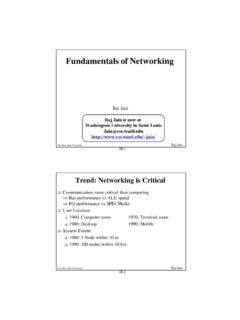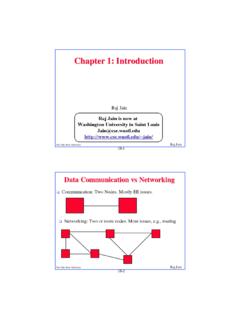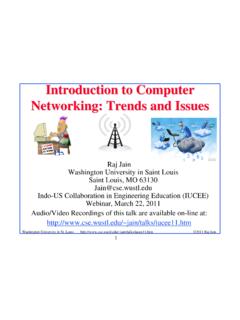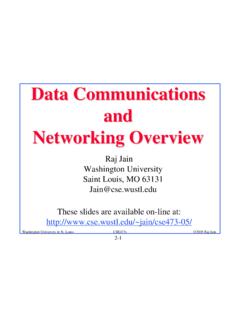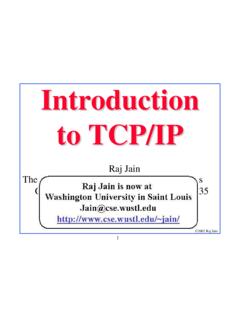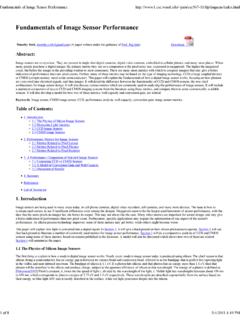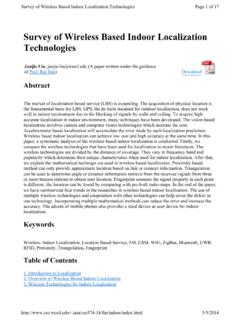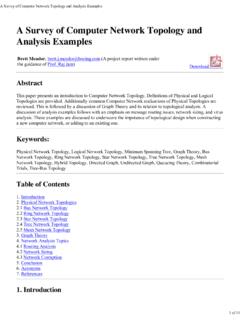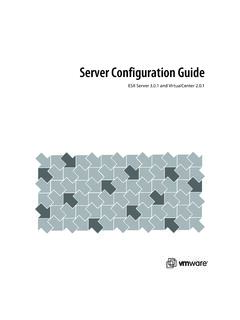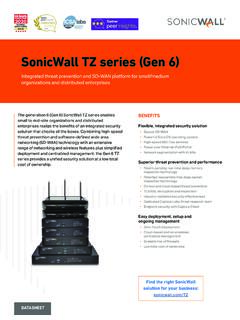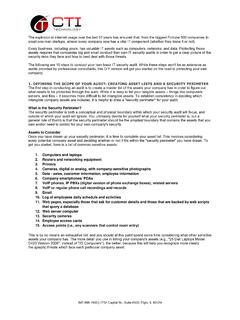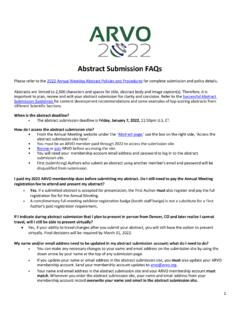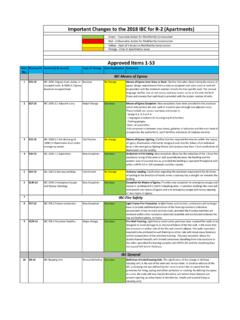Transcription of Introduction to Software Defined Networking (SDN)
1 16-1 2013 Raj ~jain/cse570-13/Washington University in St. LouisIntroduction to Introduction to Software Defined Software Defined Networking (SDN) Networking (SDN)Raj Jain Washington University in Saint Louis Saint Louis, MO 63130 slides and audio/video recordings of this class lecture are at: ~jain/cse570-13/.SDN = Separation of Control and Data PlanesSDN=OpenFlowSDN = Centralization of control planeSDN=Standard Southbound API16-2 2013 Raj ~jain/cse570-13/Washington University in St. LouisOverviewOverview1. What is SDN?2. Alternative APIs: XMPP, PCE, ForCES, ALTO3. RESTful APIs and OSGi Framework4. OpenDaylight SDN Controller Platform and ToolsNote: This is the third module of four modules on OpenFlow, OpenFlow Controllers, SDN and NFV in this 2013 Raj ~jain/cse570-13/Washington University in St. LouisOrigins of SDNO rigins of SDN SDN originated from OpenFlow Centralized Controller Easy to program Change routing policies on the fly Software Defined Network (SDN) Initially, SDN= Separation of Control and Data Plane Centralization of Control OpenFlow to talk to the data plane Now the definition has changed significantly.
2 ApplicationNetwork ControllerSwitchOverlay (Tunnels) APIS outhbound APIOpenFlow16-4 2013 Raj ~jain/cse570-13/Washington University in St. LouisWhat is SDN?What is SDN? All of these are mechanisms. SDN is not a mechanism. It is a framework to solve a set of problems Many solutionsSDN = Separation of Control and Data PlanesSDN=OpenFlowSDN = Centralization of control planeSDN=Standard Southbound API16-5 2013 Raj ~jain/cse570-13/Washington University in St. LouisOriginal Definition of SDNO riginal Definition of SDN What is SDN?The physical separation of the network control plane from the forwarding plane, and where a control plane controls several devices. 1. Directly programmable2. Agile: Abstracting control from forwarding3. Centrally managed4. Programmatically configured5. Open standards-based vendor neutralThe above definition includes How. Now many different opinions about How.
3 SDN has become more general. Need to define by What? Ref: 2013 Raj ~jain/cse570-13/Washington University in St. LouisWhat = Why We need SDN?What = Why We need SDN?1. Virtualization: Use network resource without worrying about where it is physically located, how much it is, how it is organized, Orchestration: Should be able to control and manage thousands of devices with one command. 3. Programmable: Should be able to change behavior on the Dynamic Scaling: Should be able to change size, quantity5. Automation: To lower OpEx minimize manual involvement Troubleshooting Reduce downtime Policy enforcement Provisioning/Re-provisioning/Segmentatio n of resources Add new workloads, sites, devices, and resources16-7 2013 Raj ~jain/cse570-13/Washington University in St. LouisWhy We need SDN? (Cont)Why We need SDN? (Cont)6. Visibility: Monitor resources, connectivity7. Performance: Optimize network device utilization Traffic engineering/Bandwidth management Capacity optimization Load balancing High utilization Fast failure handling8.
4 Multi-tenancy: Tenants need complete control over their addresses, topology, and routing, security9. Service Integration: Load balancers, firewalls, Intrusion Detection Systems (IDS), provisioned on demand and placed appropriately on the traffic path16-8 2013 Raj ~jain/cse570-13/Washington University in St. LouisWhy We need SDN? (Cont)Why We need SDN? (Cont)10. Openness: Full choice of How mechanisms Modular plug-ins Abstraction: Abstract = Summary = Essence = General Idea Hide the details. Also, abstract is opposite of concrete Define tasks by APIs and not by how it should be done. , send from A to B. Not : Open Data Center Alliance Usage Model: Software Defined Networking Rev , : 2013 Raj ~jain/cse570-13/Washington University in St. LouisSDN DefinitionSDN Definition SDN is a framework to allow network administrators to automatically and dynamically manage and control a large number of network devices, services, topology, traffic paths, and packet handling (quality of service) policies using high-level languages and APIs.
5 Management includes provisioning, operating, monitoring, optimizing, and managing FCAPS (faults, configuration, accounting, performance, and security) in a multi-tenant environment. Key: Dynamic Quick Legacy approaches such as CLI were not quick particularly for large networks16-10 2013 Raj ~jain/cse570-13/Washington University in St. LouisExamples Alternative APIsExamples Alternative APIs Southbound APIs: XMPP (Juniper), OnePK (Cisco) Northbound APIs: I2RS, I2 AEX, ALTO, Overlay: VxLAN, TRILL, LISP, STT, NVO3, PWE3, L2 VPN, L3 VPN Configuration API: NETCONF Controller: PCE, ForCESRef: T. Nadeau and K. Gray, SDN, O Reilly, 2013, 384 pp, ISBN:978-1-449-34230-2 (Safari Book)16-11 2013 Raj ~jain/cse570-13/Washington University in St. LouisXMPPXMPP Extensible Messaging and Presence Protocol Extensible Using XML Similar to SMTP email protocol but for near real-time communication Each client has an ID, , (John s mobile phone) Client sets up a connection with the server Client is online Presence: Server maintains contact addresses and may let other contacts know that this client is now on-line Messaging: When a client sends a chat message to another clients, it is forwarded to these other clients Messages are pushed ( real-time) as opposed to polled as in SMTP/POP : P.
6 Saint-Andre, et al., XMPP: The Definitive Guide, O Reilly, 2009, 320 pp., ISBN:9780596521264 (Safari Book)16-12 2013 Raj ~jain/cse570-13/Washington University in St. LouisXMPP (Cont)XMPP (Cont) XMPP is IETF standardization of Jabber protocol RFC 6121 defines XMPP using TCP connections. But HTTP is often used as transport to navigate firewalls All messages are XML encoded Not efficient for binary file transfers Out-of-band binary channels are often used with XMPP. A number of open-source implementations are available Variations of it are widely used in most instant messaging programs including Google, Skype, Facebook, .., many games Used in IoT and data centers for management. Network devices have XMPP clients that respond to XMPP messages containing CLI management requests You can manage your network using any other XMPP client, , your mobile phone Arista switches can be managed by XMPP, Juniper uses XMPP as a southbound protocol for SDNRef: 2013 Raj ~jain/cse570-13/Washington University in St.
7 LouisXMPP in Data CentersXMPP in Data Centers Everything is an XMPP entity. It has its own contact list and : CenterpM16-14 2013 Raj ~jain/cse570-13/Washington University in St. LouisPath Computation Element (PCE) Path Computation Element (PCE) MPLS and GMPLS require originating routers to find paths that satisfy multiple constraints including not using any backup routers and having a given bandwidth etc. This may require more computer power or network knowledge than a router may have. IETF PCE working group has developed a set of protocols that allow a Path computation client (PCC), , router to get the path from path computation element (PCE) PCE may be centralized or may be distributed in many or every is the 1 Gbps route to New York not going through Boston?Traffic Engineering DatabasePath Computation Element (PCE)Path Computation Client (PCC)16-15 2013 Raj ~jain/cse570-13/Washington University in St.
8 LouisPCE (Cont)PCE (Cont) PCE separates the route computation function from the forwarding function. Both functions may be resident in the same box or different boxes. 25+ RFCs documenting protocols for: PCE-to-PCC communication PCE-to-PCE communication (Multiple PCEs) PCE discoveryRef: : 2013 Raj ~jain/cse570-13/Washington University in St. LouisForwarding and Control Element Forwarding and Control Element SeparationSeparation (ForCES)(ForCES) IETF working group since July 2001 Control Elements (CEs) prepare the routing table for use by forwarding elements (FEs). Each CE may interact with one or more FEs There may be many CEs and FEs managed by a CE manager and a FE managerForwarding Element (FE)Control Element (CE)FE ManagerCE ManagerForwarding Element (FE)Control Element (CE)..16-17 2013 Raj ~jain/cse570-13/Washington University in St. LouisForCES (Cont)ForCES (Cont) Idea of control and data plane separation was used in BSD routing sockets in early 1990s.
9 It allowed routing tables to be controlled by a simple command line or by a route daemon. ForCES protocol supports exchange of: Port type, link speed, IP address IPv4/IPv6 unicast/multicast forwarding QoS including metering, policing, shaping, and queueing Packet classification High-touch functions, , Network Address Translation (NAT), Application-level Gateways (ALG) Encryptions to be applied to packets Measurement and reporting of per-flow traffic informationRef: 2013 Raj ~jain/cse570-13/Washington University in St. LouisSample ForCES ExchangesSample ForCES ExchangesCE ManagerCESecurity exchangeCE ID, attributesFE IDFECES ecurity exchangeFE ID, attributeInitial ConfigurationAdd these new routesGive me statsStatsPort x downNew forwarding tableSecurity exchangeList of CEs and their attributesList of FEs and their attributesFE ManagerCE ManagerFE ManagerFESecurity exchangeFE ID, attributesCE IDRef: 2013 Raj ~jain/cse570-13/Washington University in St.
10 LouisApplication Layer Traffic Optimization Application Layer Traffic Optimization (ALTO)(ALTO) IETF working group to optimize P2P traffic Better to get files from nearby peers Provide guidance in peer selection ALTO Server: Has knowledge of distributed resources ALTO Client: Requests information from servers about the appropriate peers Ratio Criteria: Topological distance, traffic charges, .. ALTO Server could get information from providers or from nodes about their characteristics, , flat-rate or volume based charging A client may get the list of potential peers and send it to the server, which can return a ordered list Also need a protocol for ALTO server discoveryRef: Y. Lee, et al., ALTO Extensions for collecting Data Center Resource Information, : J. Seedorf and E. Berger, ALTO Problem Statement, 2013 Raj ~jain/cse570-13/Washington University in St. LouisALTO ExtensionALTO Extension Now being extended to locate resources in data centers Need to be able to express resource (memory, storage, CPU, network) availability Cost of these resources Constraints on resources, , bandwidth Constraints on structure, , Power consumption ALTO client gets the info from various providers Issue of privacy of resource and cost info for the providerData Center 1 Data Center 1 Data Center 1 ALTO ClientApplication Orchestrator16-21 2013 Raj ~jain/cse570-13/Washington University in St.
